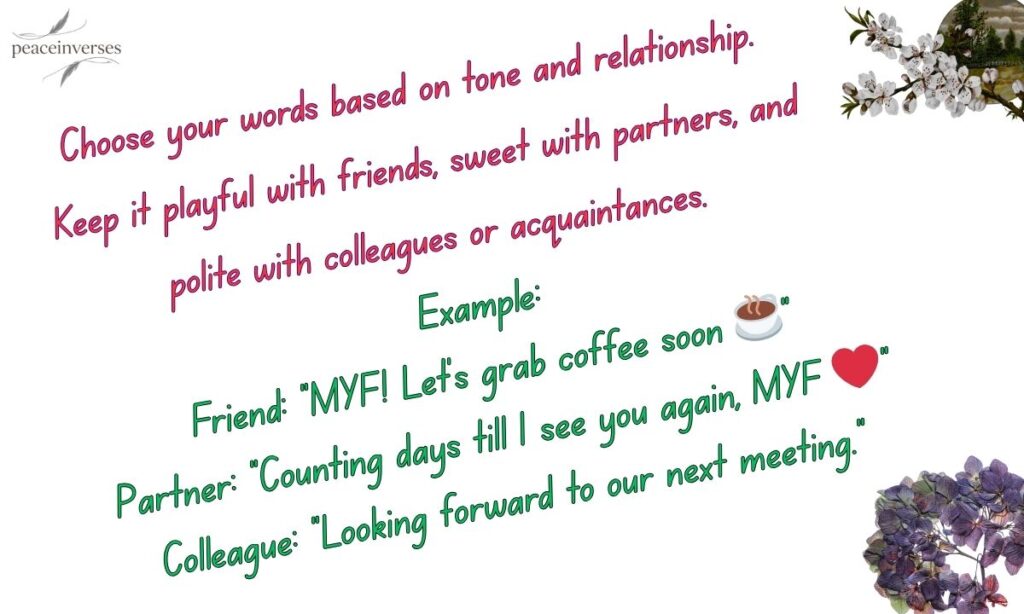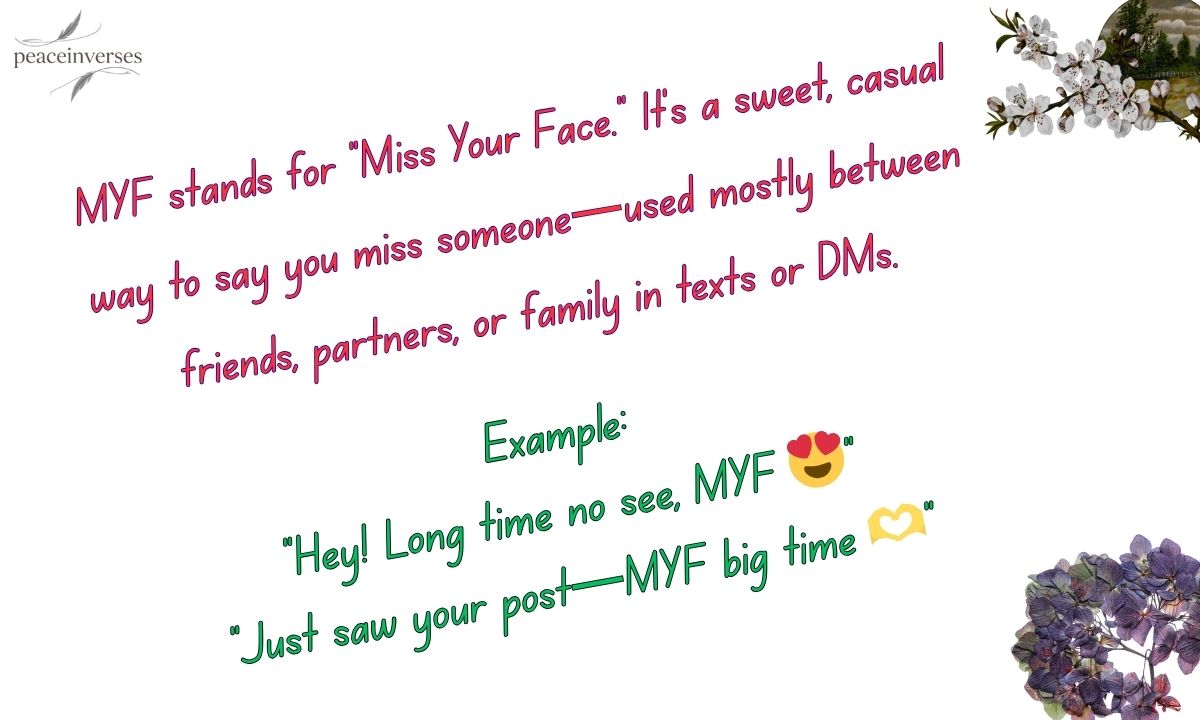Texting today isn’t just about words—it’s about tone, emotion, and timing. A few letters can carry warmth, humor, or connection, depending on how you use them. That’s where “MYF” fits perfectly—it’s one of those phrases that instantly adds a personal touch to digital conversations.
In 2025, our chats are faster but still full of feeling. We mix emojis, acronyms, and shorthand to keep messages quick yet meaningful. Knowing when and how to drop a term like “MYF” can make your texts sound effortless, friendly, and real—without crossing the line between casual and caring.
What “MYF” Stands For in Text Conversations
In texting culture, MYF has become one of those friendly, emotional shortcuts that instantly feels personal. It often appears in casual chats, posts, and private messages between people who share a close bond.
Rather than using long sentences, MYF helps express care in just a few characters. It’s short, expressive, and ideal for quick communication where warmth still matters.When you see MYF, it’s usually written with a touch of affection or nostalgia.
People use it when checking in with friends, reconnecting after a break, or reacting to photos and updates online. Its casual nature makes it perfect for relaxed settings, especially when you want to show that someone’s presence is missed in a fun and friendly way.
A Closer Look at the Meaning Behind “Miss Your Face”
At first glance, MYF sounds simple—but there’s more depth to it than most realize. The phrase “Miss your face” doesn’t just focus on looks; it’s about missing someone’s presence and personality. It reminds the other person that you miss being around them, seeing their expressions, or sharing small, everyday moments.
In modern communication, expressions like MYF often carry layered emotions. It can be playful in tone, yet meaningful in intent. For example, friends might say it to tease each other, while partners may use it to express affection. The phrase captures the comfort and familiarity that comes from knowing someone well and genuinely missing their vibe.
Emotional Layers and Subtle Intentions
Understanding MYF requires reading between the lines. While it’s lighthearted, it can hold different meanings depending on who sends it. Sometimes, it’s just a fun way to say hello; other times, it’s a quiet way of saying “I miss you” without sounding too serious. The subtlety is what makes MYF so versatile in texts and online chats.
Below are a few ways people might use MYF emotionally:
- Playful affection: Sent between friends who share inside jokes or good memories.
Example: “You still owe me coffee! MYF 😂” - Romantic warmth: Used by partners or crushes to express missing each other.
Example: “Scrolling through my gallery… MYF ❤️” - Soft nostalgia: Shared when reconnecting after months apart.
Example: “Saw an old photo from college. MYF so much!” - Casual friendliness: Used lightly, just to keep in touch.
Example: “Hey stranger, MYF! Hope you’re good.”
These layers make MYF adaptable. It works whether you’re being humorous, tender, or sincere—it always adds a touch of emotion without being overbearing.
When and Where It’s Okay to Use “MYF”
MYF fits best in personal, casual, and emotionally warm conversations. It’s not meant for formal communication or workplace settings, since its tone leans too friendly for professional spaces. The acronym thrives in relaxed digital spaces like DMs, texts, or comments, where emotions flow naturally.
The key is knowing your audience. You can send MYF to friends, family, or someone you’re close with, but avoid using it in emails or messages that require professionalism. In those settings, simple phrases like “Looking forward to catching up” or “Hope to see you soon” work better while keeping the tone polite and appropriate.
Understanding Tone, Context, and Relationship Boundaries
To use MYF correctly, you need to balance tone and relationship level. For instance, a best friend might instantly understand your humor, but a coworker might read it differently. Context defines how the message will land—so think about the setting before using it.
Here’s a clear guide to help you gauge when MYF fits and when it doesn’t:
| Context Type | Tone | Appropriate Usage Example | Better Alternative |
| Close Friends | Playful & Easygoing | “MYF! Let’s grab lunch soon 😄” | “Miss hanging out with you.” |
| Romantic Partner | Affectionate & Personal | “Counting down the days… MYF ❤️” | “Can’t wait to see you again.” |
| Family | Warm & Sincere | “Dinner feels quiet without you. MYF.” | “Miss being around you.” |
| Acquaintance | Soft & Polite | — | “Hope you’ve been well! Let’s catch up soon.” |
| Workplace | Professional | — | “Looking forward to our next meeting.” |
Using MYF right is about timing and familiarity. When your message matches the relationship and moment, it feels genuine and effortless. But if used too casually in the wrong setting, it might come across as unprofessional or overly personal.
Better Alternatives to “MYF” for Different Situations
Sometimes, using MYF doesn’t quite fit the tone or relationship. Choosing the right alternative helps you sound genuine without overdoing affection or casualness. The best replacement depends on who you’re texting and the kind of bond you share.
Let’s explore some natural alternatives that work across friendly, social, and professional settings. These phrases keep your message warm but help you match the right level of familiarity, humor, or respect.
Casual and Playful Ways to Say It
Casual alternatives work great when you’re chatting with close friends, siblings, or someone you joke around with. These lines keep the energy light while showing that you care.
- Miss seeing your face around here! – A friendly nudge for someone you haven’t seen in a while.
- It’s been ages—miss that goofy smile! – Perfect for a fun friend or classmate.
- Can’t wait to hang out again! – Adds excitement and warmth without being too sentimental.
- Been too long, MYF vibes! – Keeps the slang but adds humor.
- FaceTime soon? Need my favorite face fix! – Great for besties or long-distance friends.
These alternatives keep the conversation comfortable. They’re perfect for lighthearted messages where affection feels natural and easy.
Polite and Warm Alternatives for Social Settings
Sometimes you want to sound kind without being overly casual. These phrases are ideal for acquaintances, family friends, or distant relatives where you want warmth but still some space.
- It’s always nice catching up—let’s do it again soon.
- I’ve been thinking of you. Hope everything’s going well.
- It’s been too long since we last met. Would love to reconnect.
- Hope to see you again soon—it’s always a pleasure.
- Been missing our chats lately. Let’s plan something soon.
Each of these lines sounds natural and sincere without crossing into emotional territory. They fit perfectly in messages that need a personal but polite touch.
Professional and Respectful Substitutes for Work or Email
In business or formal communication, MYF doesn’t belong. You want to stay courteous and positive without sounding overly casual. Use these expressions when writing to colleagues, mentors, or clients.
- Looking forward to our next meeting. – Clean and professional.
- It was a pleasure collaborating with you. Let’s stay in touch. – Keeps doors open for future work.
- Hope we can work together again soon. – Friendly but formal.
- Let’s schedule a quick follow-up. Would love to reconnect. – Proactive and respectful.
- Appreciate your time and effort. Until next time. – A polite closure.
These phrases help you sound approachable but still business-appropriate. They express the same sentiment as MYF without being too personal.
How to Pick the Right Phrase for the Right Person

The secret to communicating well is knowing your audience. A phrase that sounds sweet to one person might feel awkward to another. Matching tone with relationship type is key to avoiding mixed signals.
Think about how close you are, what kind of platform you’re using, and what emotion you want to show. The right phrase feels natural—never forced or overly formal.
Quick Context Guide for Texts and Messages
Here’s a simple guide to help you decide what fits best depending on your connection and situation:
| Relationship Type | Tone | Best Expression | Why It Works |
| Close Friend | Playful | “Miss that goofy face of yours!” | Keeps humor and connection alive. |
| Romantic Partner | Affectionate | “Can’t stop thinking about your smile.” | Feels loving without being too serious. |
| Family | Warm | “Miss being around you. Let’s talk soon.” | Soft and caring tone. |
| Acquaintance | Polite | “Hope to see you again soon.” | Friendly but not overly familiar. |
| Colleague | Respectful | “Looking forward to our next catch-up.” | Maintains professionalism. |
Choosing the right expression helps your text land perfectly. It makes your message sound thoughtful and aligned with your relationship.
How “MYF” Evolved in Modern Digital Language
Like most texting acronyms, MYF started as a quick way to express emotion. Over time, it became part of a digital shorthand used to make conversations feel more personal. It reflects how people express warmth and care without typing full sentences.
The beauty of MYF lies in its balance—it’s casual enough for chats yet emotionally expressive. That makes it part of a broader texting trend where simplicity and feeling blend effortlessly.
From Slang to Everyday Emotional Expression
The shift from simple abbreviations to emotional codes shows how texting has evolved. MYF isn’t just about missing someone—it’s about maintaining connection through modern language. People want quick, expressive ways to show emotion, and acronyms like this make it possible.
Just like LOL or ILY, MYF has grown beyond slang. It’s now part of how people casually express affection, nostalgia, or friendship online—one of many short forms that keep digital chats feeling human.
16 Real-World Examples of “MYF” in Use with Context
These examples show how MYF and its variations appear in real messages. They blend tone, situation, and relationship type so you can use them naturally.
Text, DM, and Post Examples for Every Tone
- Friendship: “MYF, bestie! Let’s hang out this weekend 😍”
- Romantic: “Just saw your story… MYF and can’t wait to see you 💕”
- Reconnecting: “Hey stranger! It’s been forever, MYF big time!”
- Family: “MYF, mom. Counting days till I visit.”
- Work Mentor: “It was great collaborating—hope we meet again soon.”
- Old Classmate: “Found an old photo from graduation, MYF lol.”
- Sibling: “MYF, bro. Miss our late-night talks!”
- Long-distance Partner: “Video call soon? MYF like crazy 😭”
- Close Friend: “You always make me laugh. MYF today more than usual.”
- Acquaintance: “It’s been a while! Hope you’ve been well.”
- Teasing: “Miss your goofy face! MYF but won’t admit it 🤭”
- Online Friend: “You disappeared again haha MYF though 😅”
- Flirty: “Not gonna lie, MYF a little too much 😉”
- Supportive: “Heard you’re busy lately. Just wanted to say MYF.”
- Reunion Planning: “Can’t wait for our trip—MYF already!”
- Everyday Chat: “Work’s been wild, MYF always 🫶”
These examples show how MYF works across emotions—from friendly to romantic—and keeps your messages real.
Final Thoughts
Communication keeps evolving, but sincerity never goes out of style. MYF and similar phrases remind us that even short messages can hold genuine emotion. What matters most is matching your tone to your intent.
In 2025, language is faster, lighter, and more expressive than ever. Whether you’re texting a friend, reconnecting with someone special, or sending a polite note, use what feels natural. The best messages are always the ones that sound like you.

